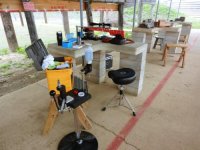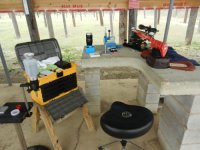A friend uses a scale just to check his charges so that they vary by less than +-.1 It is one of the Hornady electronic jobs, and he uses a cheap plastic domed lid of some sort, that he can read the scale through. If the charge is off, he dumps it back in the hopper. This is with 133. He modified the baffle in his small Harrell measure (I leave mine out) and I helped him with throwing technique, and most of his charges pass the scale test, and are dumped into his cases with a funnel, out of the scale pan.
Recently, he has switched to LT32 and that is so easy to stay close enough with that I have told him that except for checking at the beginning of a run, that he does not need to weigh each charge.
For myself, due to TV being boring, I have invested a lot of spare time in learning how to throw 133. For anyone else that is not so inclined (almost the entire shooting world) simply resorting to a RCBS Chargemaster and battery pack is the easy out, not perfect, but for short range, I think good enough.
For those occasions when I am working up a load for a rifle that I will be preloading, I have a "wind box" that shields my tuned up balance scale, that has the trickler on the inside, with its handle sticking out of one end. Because it is a bit of a pain to haul back and forth to the range I don't use it much, but when I need it it, is good to have.
I have seen a lot of matches won by shooters who threw their charges. Staying in tune, and being sharp on what the flags are telling you have more to do with the outcome than a tenth of a grain of powder. With all of the details involved, I think that one needs to figure out what the most important ones are, and concentrate on getting them right.



